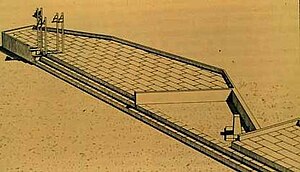Graecostasis

The Graecostasis as it may have appeared in its last construction as a permanent level "grandstand". Not illustrated is the Rostra Vetera.
|
|
| Rostra | |
|---|---|
| Comitium | |
| Curia Julia | |
| Roman government | Political institutions |
| The Graecostasis probably began as a temporary wooded structure, moved several times and eventually may have been a permanent stone edifice. | |
The Graecostasis was a platform in the Comitium near the Roman Forum, located to the west of the Rostra. The name refers to the Greek ambassadors for whom the platform was originally built after the Roman Republic conquered Greece. Placed at the southwest end of the Comitium, the platform was the designated spot for all representatives of foreign nations and dignitaries from the republic and empire's domain.
Visiting outsiders were not permitted within the Senate House or Curia and instead may have stood on this platform while waiting to meet with senators or to hear orations from the Rostra to its east side. Although one scholar has disputed this interpretation and argues that it may have served as a viewing platform for entertainment.
The Graecostasis was, as Niebuhr remarks, like privileged seats in the hall of a parliamentary assembly. The Stationes Municipiorum, of which Pliny speaks, appear to have been places allotted to municipals for the same purpose. When the sun was seen from the Curia coming out between the Rostra and the Graecostasis, it was mid-day; and an accensus of the consul announced the time with a clear loud voice.
Much of the history of the structure has been effected in the same way as other known similar monuments. When the orators on the Rostra faced north towards the Curia to speak the Graecostatsis was aligned along a hemicircle believed to have been the outer footprint of the Comitium amphitheater removed when a moratorium against permanent theatre was placed on the city. It is believed this may have been from riots stirred up by political speeches on the Rostra or a political theatrical performance or show.
While there have been excavations of the site, the exact location remains unclear. Several layers of rubble in the Comitium show constant changes within a small period of time, which raised the level of the space and, consequently the location of the platform. Many historians believe that the Rostra maintained its location in the Comitium during varied restorations and construction as that platform was a permanent fixture of Roman politics and held in an honored and elevated status, while the Graecostasis was presumed to be a simple wooden structure. A theory has been put forth that the finale phase of the structure was constructed of stone and concrete and is visible in the topmost layer directly beneath the contemporary ground level next to the remains of the original Rostra before it was moved by Julius Caesar.
...
Wikipedia
